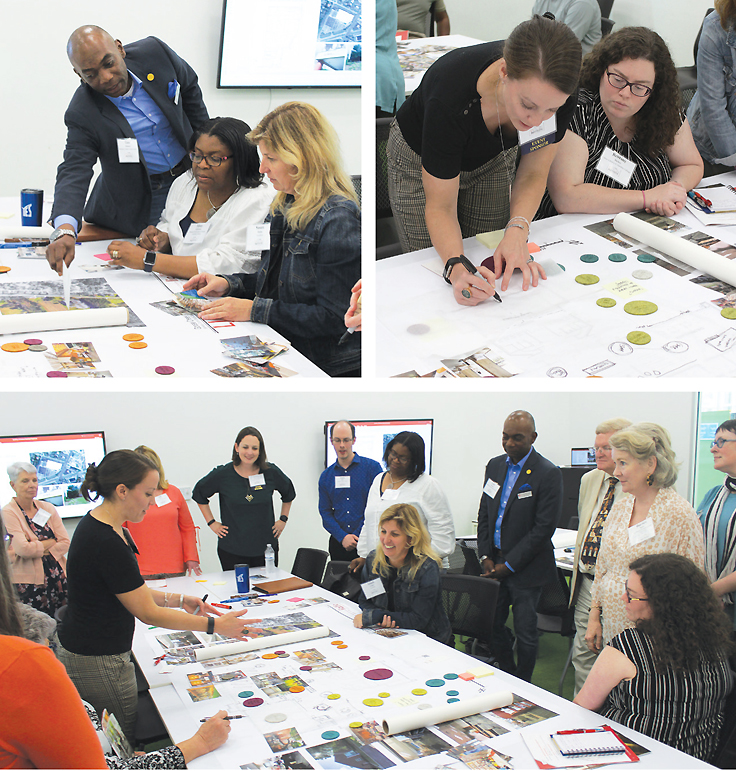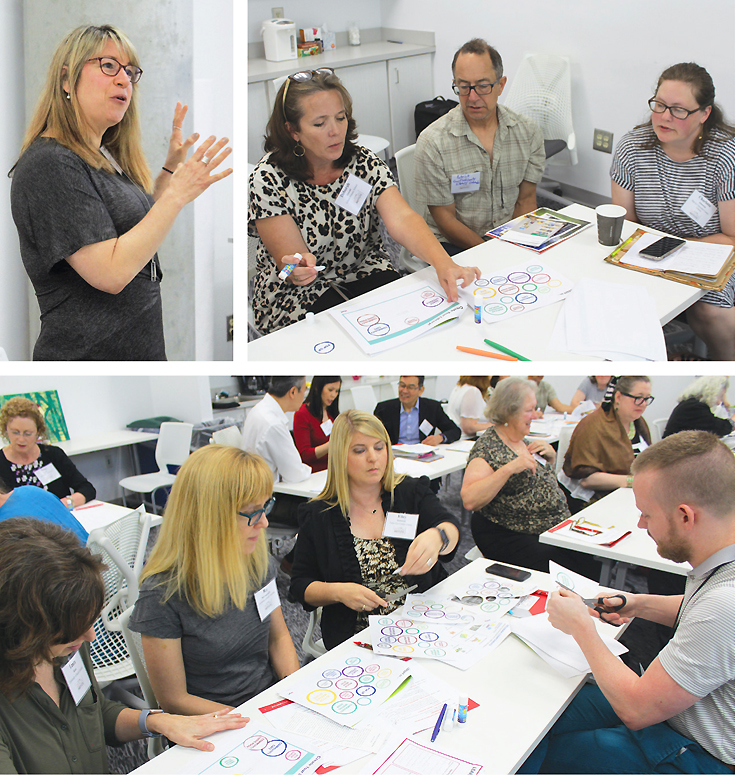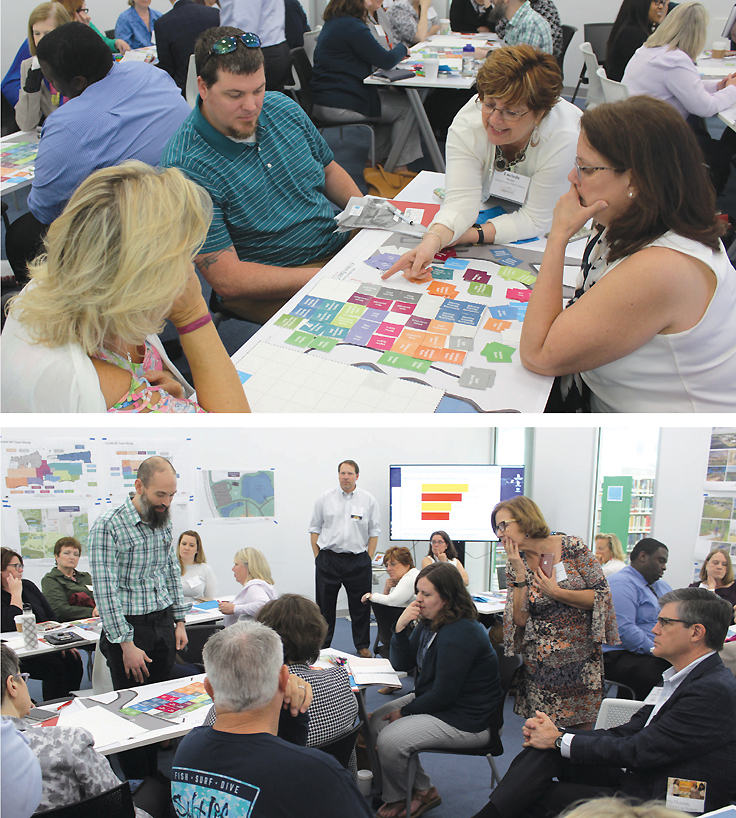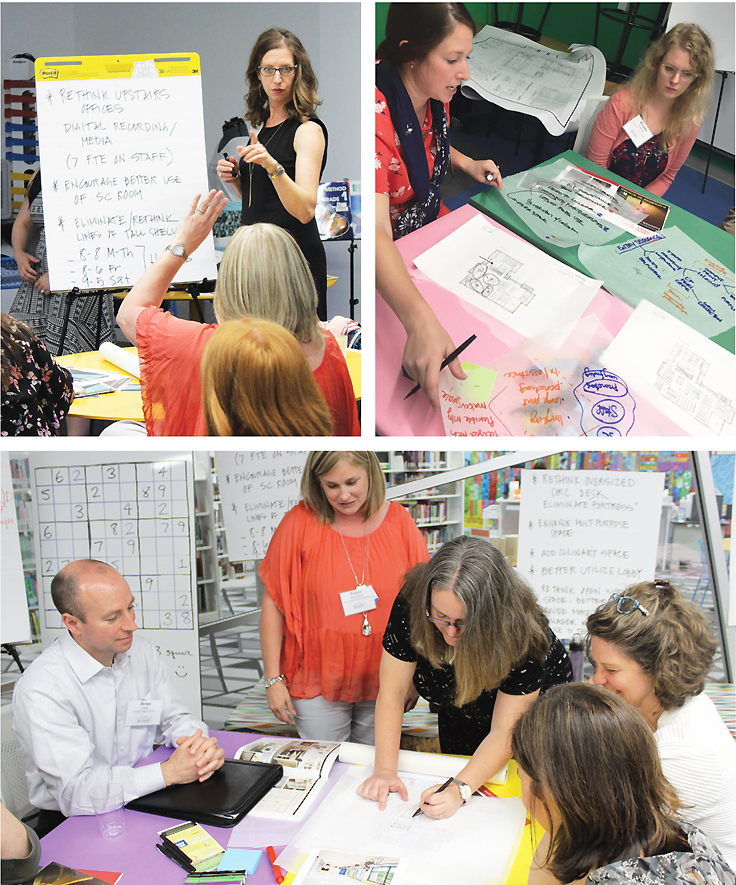4 Design Challenges from Richland | Design Institute Columbia, SC
Breakout sessions at LJ's Design Institute in Columbia, SC, featured on-the-ground brainstorming for real-life library design challenges.
ARCHITECT Liollio Architecture
THE CHALLENGE Roughly the size of Rhode Island, Berkeley County is the largest county, geographically, in South Carolina, with a population approaching 210,000. The Berkeley County Library System (BCLS) serves diverse communities with seven physical libraries (the latest, a 4,500-square-foot facility in a new YMCA, opened June 5), plus a mobile library. It’s also in dire need of a retrofit/redesign for two of its older libraries (built in 1991 and 2005, respectively), both about 13,000 square feet, to accommodate current and future needs. The biggest impediment, said Library Director Gene Brunson (top l. standing), is funding.
THE BRAINSTORM Liollio’s Jennifer Charzewski and Liz Corr took on both branches in the BCLS breakout, dividing attendees into one group each for Moncks Corner and Goose Creek. Charzewski said that the key, “when you don’t have a budget, [is to] move things around and get rid of big furniture to open up space.” Each group had carte blanche, moving felt pieces and photo cards around on layouts to create different features and spaces. To make use of Moncks Corner’s long, chute-like entry corridor, participants suggested a pop-up art gallery or quiet study nooks. Other recommendations for one or both libraries included flipping spaces, moving books and furniture to create comfortable seating areas and meeting spaces, shifting teens from cramped spaces and putting them adjacent to Maker and collaborative spaces, adding a career center next to adult computers, and switching the young learners’ toolbox closer to the children’s area. Charzewski’s proposals included lowering shelving from the current 60” or 90” height to 42”; replacing large circulation and reference desks with smaller desks or “circ perches”; and for both libraries, a children’s pop-up patio, or imagination playground, that can be wheeled outside (or occupy a meeting room), containing supplies and bean bag chairs purchased with the programming budget.—Francine Fialkoff
Photos by Kevin Henegan
Carnegie Library of Pittsburgh, PA
ARCHITECT Margaret Sullivan Studio
THE CHALLENGE Though it is located in a neighborhood rich in cultural and educational destinations, the Carnegie Library of Pittsburgh’s (CLP) main branch has been seeing usage drop; the 1895 building doesn’t meet modern needs, and faces a major upgrade. On top of the technical requirements, customers—particularly teens—want spaces to gather and talk; special collections need to be given prominence; and the front entrance requires a new, easy-to-locate lift. At the same time, many users like the traditional setting. Branch Director Jennifer Styran (top l. photo) described the building as “loved and revered,” but bridging 20th- and 21st-century library needs remains a challenge.
THE BRAINSTORM Margaret Sullivan Studio designers Neely Leslie and Lyna Vuong highlighted contextual details—location, service demographics, and space constraints—and stated that defining community needs is key to identifying solutions. They handed out Design for Experience Workshop Toolkits, with user personas specific to CLP, rangint from children to seniors. Participant groups each picked one and imagined their personalities, learning styles, and potential customer experience. Each group then placed cut-out components on a floor plan to design a library for their user, considering service areas, furnishing and equipment, traffic flows, and possible partners. The groups then presented plans and rationales, which included innovations such as an outdoor arboretum for a senior gardener, a performance area with movable walls for a college-age musician, and a community café contiguous with an early learning space for a caregiver and her four-year-old charge. Leslie and Vuong explained that the process mirrored their iterative design method of gathering input from library staff and community members. Leslie said, “It’s good to make them put themselves in someone else’s shoes and [imagine] what the library might offer.”—Lisa Peet
Photos by Kevin Henegan
Manatee County Public Library, FL
ARCHITECT HBM Architects
THE CHALLENGE The Manatee County Public Library System has been invited to build the first library in Lakewood Ranch, a 25-year-old planned community that continues to grow through phased development. The county recently acquired 74.5 acres for a library, satellite offices, and athletic fields. The library requires a facility that meets the needs of the community at its current size and which can grow with the population. Participants were asked to engage in visioning for a two-story, 24,000 square foot building, of which the library would initially occupy half and county services would use the rest; as the community grows, the county plans to move out so the library can expand.
THE BRAINSTORM The challenge for library leadership: how to optimize the building on two floors with co-tenants and preconfigure an expansion that will be low-cost and efficient down the line. Library Services Manager Glenda Lammers set the stage by describing the community’s demographics and anticipated library uses. Peter Bolek and James Shook of HBM Architects then led participants through a design thinking session, asking what each sees as the most important aspects of library services and reviewing samples of effective real-world designs. Participants then worked collaboratively to lay out a “Day One” first floor plan. After discussions, the HBM team challenged the group to “grow” the library into the second floor with as little disruption as possible. HBM closed with a discussion of ways to co-locate the library on both floors, to expand laterally instead of vertically.—John Chrastka
Photos by Kevin Henegan
Horry County Memorial Library, SC
ARCHITECTS Boudreaux & McMillan Pazdan Smith Architecture
THE CHALLENGE With 28,000 square feet over two floors in an “outdated floor plan,” Horry County Memorial Library System is looking to update the 2006 Conway Library to better focus on education for all ages, including hands-on learning initiatives such as STEM programming. “Libraries are education, and education is never irrelevant,” said Director Cindy Thornley as she framed the goals of the project for the participants. On the table were issues around space needs for middle schoolers and retirees, meeting rooms of various sizes, as well as bulky inflexible furniture, shelving that blocked natural views and light, and open staff space that needed more structure to support the team. With a laundry list of issues to consider, Thornley appealed to the group to help the library focus on engagement.
THE BRAINSTORM Ideas flowed, with the participants divided into four groups to reimagine the spaces from the point of view of various users. Working with floor plans, rice paper, and colored markers, they dug in. Solutions included reducing demand for shelving by leveraging space in an administration building for low-circulation materials, bringing services to one central desk, and offering more mobile computing devices to allow for fewer desktops in use for public access. The group that tackled the snowbirds and retirees argued for services up front for easy access, space to socialize, and a mid-sized room for programming related to their needs. That social space emerged—variously articulated by each group—as a central element on the ground floor made possible by moving staff space upstairs. Enter: the intergenerational living room.—Rebecca T. Miller
Top right photo by Rebecca T. Miller; all other photos by Kevin Henegan
RELATED
ALREADY A SUBSCRIBER? LOG IN
We are currently offering this content for free. Sign up now to activate your personal profile, where you can save articles for future viewing













Add Comment :-
Comment Policy:
Comment should not be empty !!!